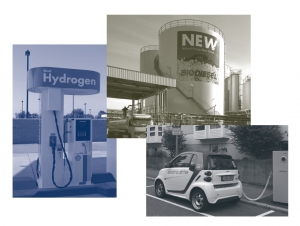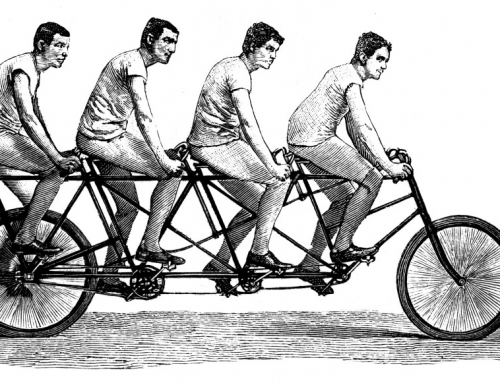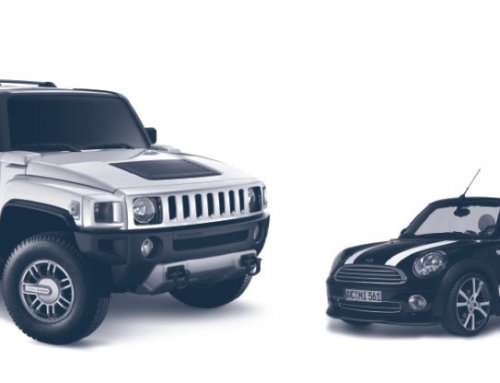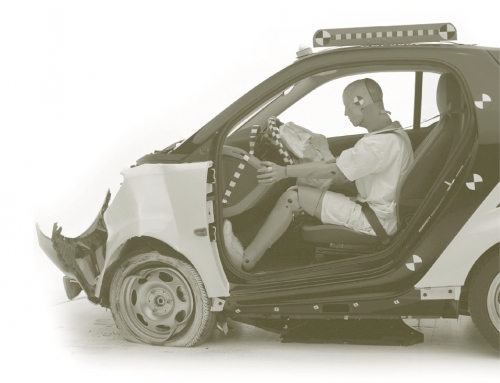“The Stone Age came to an end not because we had a lack of stones, and the oil age will come to an end not because we have a lack of oil.”
—Sheik Zaki Yamani, Oil Minister for Saudi Arabia (1962–1986)
Contrary to popular belief, the world is awash in fossil energy, much of which can be readily converted into fuels for our cars, trucks, and planes. We are not running out of fossil fuels.
The abundance of fossil fuels means we are unlikely to see high fuel prices due to scarcity. Indeed, most analysts predict that future oil prices will not be much higher than today’s, apart from occasional peaks due, for example, to conflicts in the Middle East. Prices might even end up lower as new exploration and extraction technologies for shale oil, heavy oils, deep-sea oil, and oil sands make it cheaper and easier to extract fossil energy. Thus, we cannot depend on high oil prices to reduce transport energy use and greenhouse gas (GHG) emissions.
We are not running out of fossil fuels.
There are already 1.2 billion vehicles on the world’s roads, most of which are in the rich countries of Europe, North America, and Japan. Billions more people will buy vehicles over the next century, especially in developing countries such as China and India. This raises the question: can wealthy countries not only curb their appetite for fossil energy, but also lead in developing and adopting new low-carbon lifestyles? How can mobility and accessibility be increased without disrupting ecosystems, altering the climate, depleting water supplies and extinguishing species?
We need to wean ourselves off fossil fuels—and the GHG emissions they produce—and rebuild our cities and transportation systems to be far more energy efficient. We need to shift to a world that relies on sun, water, wind, and plants for energy. We need visions, strategies, and action.
Crafting visions to reduce GHG emissions can focus public attention on what is possible and what transformations are needed. But far more important and far more challenging is the question of how we build pathways to get from here to there, with specific incremental steps to achieve desirable long-term outcomes. These pathways require a mix of strategies and technologies, which can be sorted into three legs of the transportation stool: mobility, fuel type, and vehicle efficiency. These categories are represented by a simple formula:
Mobility (vehicle miles traveled)
x Carbon Intensity of Energy (GHG emissions/unit of energy)
x Vehicle Energy Efficiency (energy use/vehicle mile)
= GHG Emissions
Mobility: Beyond Car-Centric Cities
The first leg of the transportation stool is mobility, which includes vehicle use and the infrastructure and land use that support it. In many rich countries, and increasingly in emerging economies, personal cars dominate metropolitan travel. In the US, for example, personal vehicles account for 85 percent of passenger miles traveled, air travel for about 10 percent, public transportation for less than 3 percent, and bicycles and walking less than 2 percent. In Europe, where cities are more compact and fuel prices much higher, public transport has shrunk to only about 16 percent of passenger miles traveled. Walking accounts for about 20 percent of trips in much of Europe and Japan, though the trips are short and thus account for only a small share of total travel.
Reliance on personal vehicles makes transforming our cities and transportation systems a daunting challenge. In the US, passenger transport has changed little in over 60 years. While cars are safer, more reliable, and more energy efficient, they continue to perform at similar speeds and capacities and continue to be powered by internal combustion engines and petroleum. Highways, too, have changed little over the last 60 years, and for the most part remain toll-free, serve all vehicle types, and provide roughly the same performance.
Transit, too, has seen little innovation since the 1950s. The concept of bus rapid transit (BRT), where buses operate in platoons over dedicated rights-of-way, is one of the few significant innovations in intervening decades. Aside from BRT, transit operates with nearly identical service, capacity, and performance. US rail transit technology has improved, but rail ridership has decreased; heavy and light rail systems together carry less than one percent of passenger travel. Even in Europe, where ridership is more robust, rail transit carries only seven percent of overall passenger travel.
We need much more innovation. We need a new model of mobility and accessibility, especially in rapidly expanding economies such as Brazil, China, and India. Rich countries are now largely locked into car-centric development, but even car-centric cities still have the opportunity to reduce car use by expanding innovative mobility services, improving communication technologies, and charging full-cost prices for vehicles, fuels, roads, and parking. Better land use policies, too, will reduce vehicle use.
Car-centric cities still have the opportunity to reduce car use by expanding innovative mobility services, improving communication technologies, and charging full-cost prices for vehicles, fuels, roads, and parking.
One promising legislative initiative is California’s “Sustainable Communities Act of 2008,” known as SB375. SB375 imposes on cities a greenhouse gas target for passenger travel and provides a framework to transform the mix of mobility services, land use, institutions, and behaviors that underlie our cities.
The information and communication revolution is bringing efficient, cost effective mobility services that can fill the gap between single-occupant cars and bus and rail transit. Vans and small buses can respond to real-time trip requests through demand-responsive transit services. Travelers located near each other self-organize carpools in real time using smart carpooling. And smart car and bike sharing facilitate one-way trips through shared vehicle use. Proliferating start-up companies are beginning to offer all these services, but they still account for only a tiny share of urban travel.
Additional benefits can come from enhanced data gathering and road pricing to improve traffic management. Innovations such as high occupancy toll lanes are a step toward more rational use of roads, and collection of “big data” from sensors and smart phones will lead to better design and management of roads, public transit, and new mobility services. Another innovation—automated vehicle technology—provides more potential for greater access at lower cost (but also runs the risk of encouraging more driving).
These strategies are not original ideas, and many have not yet been vetted or embraced. Concerns about privacy, opposition from taxi companies, and liability concerns all threaten the spread of innovative mobility services. But changes are afoot. Many new companies provide real-time mobility services, and some are preparing to market small neighborhood cars. Some cities use pricing to manage traffic flows and parking. Other cities are establishing bus rapid transit systems.
Unfortunately, these initiatives are fragmented in scattered cities. Therein lies the real challenge. No one technology, service, or land use change will substantially reduce car dependency by itself. Travelers will use more sustainable modes in large numbers only if they gain access to a suite of mobility services, reinforced with pricing and better non-car infrastructure.
Reducing the Carbon Intensity of Fuels
Vehicle fuel, the second leg of the transportation stool, adds carbon and other greenhouse gases to our atmosphere and threatens our climate. Oil companies are investing hundreds of billions of dollars in unconventional oil production such as shale oil, heavy oils, deep-sea oil, and oil sands. They focus on carbon-intense unconventional oil production, rather than renewable energy, for two reasons: 1) OPEC countries have nationalized their oil supplies, thereby reducing access by large investor-owned western oil companies to the most abundant conventional oil reserves; and 2) oil companies’ core competencies are best suited to building large (fossil) projects rather than small renewable energy projects.
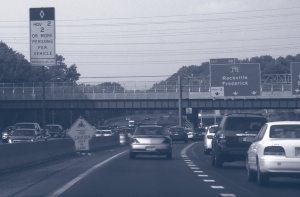 To invest in a sustainable future, we must shift investment from fossil sources to renewable sources, but replacing petroleum will be difficult and slow. The hegemony of petroleum creates multiple barriers for new fuels including liability, public skepticism, and sunk investment in supportive infrastructure like refineries, pipelines, and fuel stations. Politicians and the media are quick to embrace new transportation fuels—methanol in the 1980s, electric vehicles in the early 1990s, and hydrogen in the early 2000s—but the barriers and the inertia inevitably hamper newer fuels’ potential. This fuel du jour phenomenon, whereby new fuels are hyped and then quickly abandoned, describes the recurring failures of alternative fuels over the past few decades.
To invest in a sustainable future, we must shift investment from fossil sources to renewable sources, but replacing petroleum will be difficult and slow. The hegemony of petroleum creates multiple barriers for new fuels including liability, public skepticism, and sunk investment in supportive infrastructure like refineries, pipelines, and fuel stations. Politicians and the media are quick to embrace new transportation fuels—methanol in the 1980s, electric vehicles in the early 1990s, and hydrogen in the early 2000s—but the barriers and the inertia inevitably hamper newer fuels’ potential. This fuel du jour phenomenon, whereby new fuels are hyped and then quickly abandoned, describes the recurring failures of alternative fuels over the past few decades.
Looking forward, there are three sets of promising energy options. The first is electricity for vehicles, which provide large environmental benefits, and battery technology is steadily improving. But will the short attention span of politicians and media again kill off this attractive alternative before it has time to gain consumer acceptance, achieve scale economies, benefit from learning-by-doing, and fully realize the benefits of supportive policies?
Hydrogen is a second promising option. Hydrogen may have the greatest potential to replace petroleum across transportation, but it faces even greater start-up and fuel-distribution challenges. Not only must the vehicle industry transform from combustion engines to fuel cells, but the fuel industry must also shift from supplying gasoline and diesel fuel to supplying hydrogen.
Biofuels are the third major contender to reduce oil dependency. A downside to biofuels is that they require ample land. Diverting land to energy production is problematic because it reduces farming areas and releases huge amounts of carbon embedded in soils and plants. Biofuels are most promising if made from urban, forestry, and crop wastes, which do not require additional land.
Policies should reward and support options that are most likely to reduce oil dependency and carbon intensity. Performance-based policies that reward carbon reduction, such as the low carbon fuel standard in California, are promising, especially when accompanied by incentives that help boost initial investments in hydrogen stations and advanced biofuel technologies. Without strong policies, high-GHG petroleum fuels will sweep aside all alternatives, including electric vehicles.
Rolling Out Efficient Vehicles
Improving vehicle efficiency is the third and most promising strategy for reducing GHG emissions for the next few decades. Aggressive policies in most large car markets, including Europe, the US, China, and Japan, aim to cut fuel consumption per vehicle roughly in half in the next 15 years. Importantly, the international auto industry has made energy efficiency a top priority. Car manufacturers are using more lightweight materials, more efficient transmissions, better combustion technology, improved aerodynamics, and hybrid engines. They are also developing pure battery-electric vehicles, plug-in electric hybrids, and hydrogen-powered fuel cell electric vehicles. By 2035, a large proportion of new vehicle sales around the world are likely to be plug-in and fuel cell vehicles. The combination of efficiency improvements and electrification could lead to an 80 percent reduction in greenhouse-gas emissions for light duty vehicles (per vehicle-mile) by 2050.
The combination of efficiency improvements and electrification could lead to an 80 percent reduction in greenhouse-gas emissions for light duty vehicles (per vehicle-mile) by 2050.
Vehicle electrification is key to the long-term sustainability of vehicles. Electrification includes a spectrum of technologies, from those operating on gasoline or diesel fuel but assisted by batteries and electric motors, to those operating solely on electricity and/or hydrogen.
Today, every major car company is actively pursuing zero-emission technologies, and most have such vehicles in production. The challenge is to sustain the momentum. Costs of new technology are always high. Strong, durable policies are needed to keep automakers and consumers engaged, including the following:
• Incentives and mandates for early vehicle production,
• Government support of charging and hydrogen supply infrastructure,
• Market-based policies that internalize the cost of climate change and provide incentives to consumers and automakers to buy and sell low-carbon vehicles and fuels, and
• Performance-based standards to provide a regulatory framework for automakers as they plan for the future.
While cars are a big success story, trucks are not. Truck efficiency improvements are much slower and early regulations in Europe, the US, and Japan are much weaker than those for light duty vehicles. More stringent performance standards are likely to be developed in the future. The bigger obstacle, though, is that most current low-carbon energy alternatives are unsuitable for trucks. Trucks are heavy and tend to travel long distances each day. Most trucks cannot be easily powered by electricity because the batteries needed to provide sufficient energy are very heavy and bulky. Fuel cells may be a more feasible option for trucks, since they are far lighter and smaller than batteries. The best long-term energy option for trucks, however, will probably be low-carbon biofuels.
Conclusion
We need to change how we harness and use energy for transport. All of us need to confront the reality that transportation as we know it is incredibly expensive, resource-intensive, and socially unjust. We need to improve our technologies and learn new behaviors. But new technologies and new behaviors do not appear spontaneously; they take time. Climate change, a compelling reason for these new technologies and behaviors, is not directly experienced, unlike the more observable problems of smog, polluted water, and marred landscapes. With no direct, observable consequences to increased greenhouse gas emissions, it is difficult to pursue new transportation and energy pathways that are initially more expensive and less convenient.
And yet, sweeping changes are needed. If we don’t make those tough economic choices and major lifestyle changes, then we condemn our grandchildren and great-grandchildren to an environmentally compromised world. Who has the courage to step forward and lead? It is morally and economically irresponsible to leave this looming disaster as our legacy. We need to muster the necessary courage and channel our innovative spirit if we hope to create a better world.
This article is adapted from the Commemorative Lecture that Daniel Sperling delivered in Tokyo when he was awarded the Blue Planet Prize in 2013. http://www.af-info.or.jp/en/blueplanet/doc/prof/2013profile-eng.pdf


